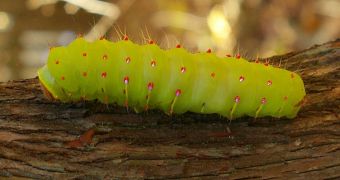The natural world is teeming with examples of cooperation between parasites and the organisms they infect. At times, the merger can be beneficial to both species, and this appears to be the case when caterpillars are infected by parasitic worms too.
It would seem that, when the worms infect particular species of caterpillar, they begin to underlie the production of a relatively intense bioluminescence, which allows the creature to fend off predators.
This defense mechanism works like a charm. The otherwise harmless-looking caterpillars are transformed into creatures that are very red, and which glow to some extent. The effect is caused by the parasitic nematode Heterorhabditis bacteriophora.
When the worms infect the caterpillars of the greater wax moth (Galleria mellonella), the insects turn persistently pink-red, and start for bioluminesce for brief periods of time. In tests conducted on these caterpillars, it was demonstrated that they were safer than their unaffected peers.
Researchers used a group of 16 European robins, which showed a preference for caterpillars that were not bioluminescent. Details of these experiments are detailed in a paper that will appear in an upcoming issue of the esteemed journal Animal Behavior.
“I think the cool thing is that it’s the first example, to our knowledge, of a parasite manipulating its host to avoid being eaten,” argues expert Andy Fenton, who is based at the University of Liverpool, in England, Wired reports.
The new investigation is also among the first to show how the genes of a particular species, the invading parasite, can force the genes of another organism, in this case the caterpillar, to change, and engage in actions that it would otherwise be incapable of doing.
Analyzing these interplays in greater detail could make it easier for researcher to understand the joint evolution of these two species. Understanding how the parasites learned to steer their hosts clear of natural predators would be a major breakthrough in the field.
Caterpillars are the larval forms of insects such as moths and butterflies, but they are oftentimes considered to be pests in agriculture. This happens because they have a voracious appetite.
When unleashed upon a tree, a team of caterpillars can easily strip it bare in no time, eating all the leaves, and leaving the tree to die. Generally, they produce a lot of damage to agriculture practices, especially on lands where monocultures are grown.

 14 DAY TRIAL //
14 DAY TRIAL //